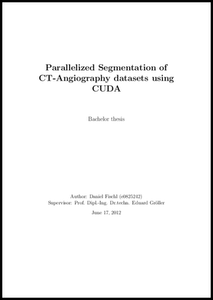Information
- Publication Type: Bachelor Thesis
- Workgroup(s)/Project(s):
- Date: 2012
- First Supervisor: Eduard Gröller
Abstract
Segmentation of CT-Angiography datasets is an important and difficult task. Several algorithms and approaches have already been invented and implemented to solve this problem. In this work, we present automatic algorithms for the segmentation of these CTA datasets, implemented in CUDA, and evaluate our results regarding speed and error rates. Starting with local approaches like thresholding we pro- ceed to global, object-based algorithms, like region growing and a newly developed algorithm based on dual energy CT scans (DECT), the XOR-Algorithm, presented by Karimov et al.[6] A limitation of using graphics hardware is the restricted amount of memory, which led us to use a slab-based processing approach (see section 5.3). The requirement of this work was a complete GPU implementation. But since not every task is appropriate for parallelizing, it was necessary to use iteratively parallel algorithms. This strategy though introduced speed problems that had to be analyzed and were partly solved. This work presents the principle of these GPU methods and compares them to their CPU counterparts. In the end, the quality of each algorithm is analyzed and they are compared against each other, in order to find an acceptable completely automatic segmentation algorithm for distinguishing between different types of tissues (e.g. vessels, bones, soft tissue, ...).Additional Files and Images
Weblinks
No further information available.BibTeX
@bachelorsthesis{FISCHL-2012-CTASEG,
title = "Parallelized Segmentation of CT-Angiography Datasets Using
CUDA",
author = "Daniel Fischl",
year = "2012",
abstract = "Segmentation of CT-Angiography datasets is an important and
difficult task. Several algorithms and approaches have
already been invented and implemented to solve this problem.
In this work, we present automatic algorithms for the
segmentation of these CTA datasets, implemented in CUDA, and
evaluate our results regarding speed and error rates.
Starting with local approaches like thresholding we pro-
ceed to global, object-based algorithms, like region growing
and a newly developed algorithm based on dual energy CT
scans (DECT), the XOR-Algorithm, presented by Karimov et
al.[6] A limitation of using graphics hardware is the
restricted amount of memory, which led us to use a
slab-based processing approach (see section 5.3). The
requirement of this work was a complete GPU implementation.
But since not every task is appropriate for parallelizing,
it was necessary to use iteratively parallel algorithms.
This strategy though introduced speed problems that had to
be analyzed and were partly solved. This work presents the
principle of these GPU methods and compares them to their
CPU counterparts. In the end, the quality of each algorithm
is analyzed and they are compared against each other, in
order to
find an acceptable completely automatic
segmentation algorithm for distinguishing between different
types of tissues (e.g. vessels, bones, soft tissue, ...).",
address = "Favoritenstrasse 9-11/E193-02, A-1040 Vienna, Austria",
school = "Institute of Computer Graphics and Algorithms, Vienna
University of Technology ",
URL = "https://www.cg.tuwien.ac.at/research/publications/2012/FISCHL-2012-CTASEG/",
}


